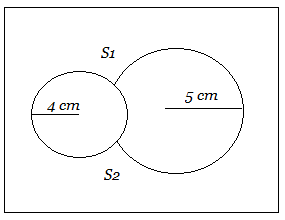
Two soap bubbles of radii ${{r}_{1}}$ and ${{r}_{2}}$ equal to 4 cm and 5 cm are touching each other over a common surface ${{S}_{1}}{{S}_{2}}$. Then its radius will be

A. \[{\rm{4\,cm}}\]
B. \[{\rm{20\,cm}}\]
C. \[{\rm{5\,cm}}\]
D. \[{\rm{4}}{\rm{.5\,cm}}\]
Answer
217.5k+ views
Hint: In our case, we are provided with the data that there are two soap bubbles with radii of 4cm and 5cm and they are touching each other. Here we are asked to determine the radius of the soap bubble in the common surface. For that, we have to use the formula \[{{\rm{P}}_1}{\rm{ - }}{{\rm{P}}_2} = \dfrac{{4{\rm{T}}}}{{\rm{r}}}\] to determine the difference and to get the desired answer.
Formula used:
Radius of the bubble can be determined using the formula
\[{\rm{r}} = \dfrac{{{{\rm{r}}_1}{{\rm{r}}_2}}}{{{{\rm{r}}_1} - {{\rm{r}}_2}}}\]
Complete step by step solution:
We have been provided in the question that, two soap bubbles of radii \[{{\rm{r}}_1}\] and \[{{\rm{r}}_2}\] equal to \[{\rm{4cm}}\] and \[{\rm{5cm}}\] are touching each other over a common surface \[{{\rm{S}}_1}{{\rm{S}}_2}\]. And we are asked to determine the radius.Any soap bubble that has excess pressure inside is given by the expression,
\[{P_{{\rm{excess }}}} = \dfrac{{4T}}{r}\]
From the above expression, we can write the value of \[{P_1}\] as
\[{P_1} = \dfrac{{4T}}{4}\]----- Equation (1)
And also, we can write the value of \[{P_2}\] as below, we have
\[{P_2} = \dfrac{{4T}}{5}\]----- Equation (2)
The differences in the two pressures will be used to calculate the radius of the new surface.
\[{{\rm{P}}_1}{\rm{ - }}{{\rm{P}}_2} = \dfrac{{4{\rm{T}}}}{{\rm{r}}}\]
Now, we have to substitute the values of Equation (1) and Equation (2) in the above formula, we get
\[\dfrac{{4{\rm{T}}}}{4} - \dfrac{{4{\rm{T}}}}{5} = \dfrac{{4{\rm{T}}}}{r}\]
Now, we have to multiply both sides by r, we get
\[\dfrac{{\rm{1}}}{5}{\rm{rT}} = 4{\rm{T}}\]
Now, we have to divide both sides by \[\dfrac{T}{5}\] we obtain
\[\dfrac{{\dfrac{1}{5}rt}}{{\dfrac{t}{5}}} = \dfrac{{4t}}{{\dfrac{t}{5}}}\]
On solving the above by cancelling the similar terms, we get
\[\dfrac{1}{5}rt = 4t\]
Cancel t on both sides of the equation, we get
\[\dfrac{1}{5}r = 4\]
Now, we have solve for \[r\] by moving \[5\] in the denominator to the right side of the equation, we get
\[r = 20\,cm\]
Therefore, the radius will be \[r = 20\,cm\].
Hence, the option B is correct.
Note: Students should be careful in solving these types of problems because; it includes some formulas and concepts to be remembered. Here, we have determined the radius of the bubble. For that, we have used the formula \[{P_{{\rm{excess }}}} = \dfrac{{4T}}{r}\] to get the desired answer. The formula \[{\rm{r}} = \dfrac{{{{\rm{r}}_1}{{\rm{r}}_2}}}{{{{\rm{r}}_1} - {{\rm{r}}_2}}}\] can also be used to determine the radius of the bubble. So, one should be careful in applying formulas to get the correct answer.
Formula used:
Radius of the bubble can be determined using the formula
\[{\rm{r}} = \dfrac{{{{\rm{r}}_1}{{\rm{r}}_2}}}{{{{\rm{r}}_1} - {{\rm{r}}_2}}}\]
Complete step by step solution:
We have been provided in the question that, two soap bubbles of radii \[{{\rm{r}}_1}\] and \[{{\rm{r}}_2}\] equal to \[{\rm{4cm}}\] and \[{\rm{5cm}}\] are touching each other over a common surface \[{{\rm{S}}_1}{{\rm{S}}_2}\]. And we are asked to determine the radius.Any soap bubble that has excess pressure inside is given by the expression,
\[{P_{{\rm{excess }}}} = \dfrac{{4T}}{r}\]
From the above expression, we can write the value of \[{P_1}\] as
\[{P_1} = \dfrac{{4T}}{4}\]----- Equation (1)
And also, we can write the value of \[{P_2}\] as below, we have
\[{P_2} = \dfrac{{4T}}{5}\]----- Equation (2)
The differences in the two pressures will be used to calculate the radius of the new surface.
\[{{\rm{P}}_1}{\rm{ - }}{{\rm{P}}_2} = \dfrac{{4{\rm{T}}}}{{\rm{r}}}\]
Now, we have to substitute the values of Equation (1) and Equation (2) in the above formula, we get
\[\dfrac{{4{\rm{T}}}}{4} - \dfrac{{4{\rm{T}}}}{5} = \dfrac{{4{\rm{T}}}}{r}\]
Now, we have to multiply both sides by r, we get
\[\dfrac{{\rm{1}}}{5}{\rm{rT}} = 4{\rm{T}}\]
Now, we have to divide both sides by \[\dfrac{T}{5}\] we obtain
\[\dfrac{{\dfrac{1}{5}rt}}{{\dfrac{t}{5}}} = \dfrac{{4t}}{{\dfrac{t}{5}}}\]
On solving the above by cancelling the similar terms, we get
\[\dfrac{1}{5}rt = 4t\]
Cancel t on both sides of the equation, we get
\[\dfrac{1}{5}r = 4\]
Now, we have solve for \[r\] by moving \[5\] in the denominator to the right side of the equation, we get
\[r = 20\,cm\]
Therefore, the radius will be \[r = 20\,cm\].
Hence, the option B is correct.
Note: Students should be careful in solving these types of problems because; it includes some formulas and concepts to be remembered. Here, we have determined the radius of the bubble. For that, we have used the formula \[{P_{{\rm{excess }}}} = \dfrac{{4T}}{r}\] to get the desired answer. The formula \[{\rm{r}} = \dfrac{{{{\rm{r}}_1}{{\rm{r}}_2}}}{{{{\rm{r}}_1} - {{\rm{r}}_2}}}\] can also be used to determine the radius of the bubble. So, one should be careful in applying formulas to get the correct answer.
Recently Updated Pages
Arithmetic, Geometric & Harmonic Progressions Explained

Cartesian Form of Vector Explained: Formula, Examples & Uses

Apparent Frequency Explained: Formula, Uses & Examples

Calorimetry: Definition, Principles & Calculations

Centrifugal Force Explained: Definition, Formula & Examples

Charge in a Magnetic Field: Definition, Formula & Examples

Trending doubts
JEE Main 2026: Application Form Open, Exam Dates, Syllabus, Eligibility & Question Papers

Derivation of Equation of Trajectory Explained for Students

Hybridisation in Chemistry – Concept, Types & Applications

Understanding the Angle of Deviation in a Prism

Understanding Collisions: Types and Examples for Students

How to Convert a Galvanometer into an Ammeter or Voltmeter

Other Pages
JEE Advanced Marks vs Ranks 2025: Understanding Category-wise Qualifying Marks and Previous Year Cut-offs

Understanding Atomic Structure for Beginners

Ideal and Non-Ideal Solutions Explained for Class 12 Chemistry

Degree of Dissociation: Meaning, Formula, Calculation & Uses

Understanding Electromagnetic Waves and Their Importance

Understanding the Electric Field of a Uniformly Charged Ring




